Legionella Risk Assessment Tool
Recommended Actions
When you hop on a bus or train, you probably think about schedules, fares, and maybe a quick snack. Legionnaire's disease is a serious form of pneumonia caused by inhaling water‑borne bacteria. The disease isn’t something you hear about every day, but recent reports show that public transportation can become a hidden source if water systems aren’t cared for. Below you’ll find what the illness is, how it can travel through buses, trains and subways, and practical steps you can take whether you run a fleet or simply ride the daily commute.
Understanding Legionnaire's Disease
Legionella is a gram‑negative bacterium that thrives in warm water environments. When the bacteria multiply inside plumbing, cooling towers, or showerheads, they can become airborne in tiny droplets called aerosols. Breathing in these droplets may trigger Legionnaire’s disease, which presents like flu‑type symptoms but can quickly progress to severe pneumonia.
The disease was first identified after a 1976 outbreak at a Pennsylvania convention center, which gave it the name “Legionnaires’” after the group that fell ill. Since then, health agencies such as the CDC have tracked thousands of cases worldwide. In the UK, the NHS reports an average of 40‑50 confirmed cases each year, with a case‑fatality rate hovering around 10% for hospitalized patients.
How Legionella Moves Through Water Systems
The bacterium loves temperatures between 20°C and 45°C (68°F-113°F). Anything that keeps water in that range-like a cooling tower on a city bus, a train’s air‑conditioning condensate line, or a subway’s sprinkler system-offers a breeding ground. Once a biofilm forms on the inside of pipes, Legionella can multiply unnoticed. When the system turns on, a burst of water can atomize the bacteria, and the resulting aerosol travels through the cabin air.
Three key factors amplify the risk:
- Stagnant water: Vehicles idle for long periods without water flow allow bacteria to settle.
- Inadequate disinfection: Chlorine or copper‑silver ionization must be maintained at recommended levels; otherwise, the bacteria survive.
- Poor ventilation: Recirculated air without fresh intake can carry aerosols longer, increasing inhalation chances.
Public Transportation as a Vector
While hospitals and hotels dominate headlines, buses, trains, and subways present unique challenges. Below is a quick look at each mode.
| Transport Mode | Typical Water Source | Common Legionella Hotspots | Relative Outbreak Risk |
|---|---|---|---|
| Public bus | On‑board air‑conditioning cooling tower | Condensate tanks, spray nozzles | Low‑Moderate |
| Train carriage | HVAC system with water‑cooled heat exchangers | Heat exchangers, wash‑down hoses | Moderate |
| Subway system | Station cooling towers & underground drainage | Cooling tower basins, platform misting | Moderate‑High |
Notice that the relative outbreak risk isn’t just about passenger numbers; it reflects how often water‑based equipment runs and how easy it is to clean.
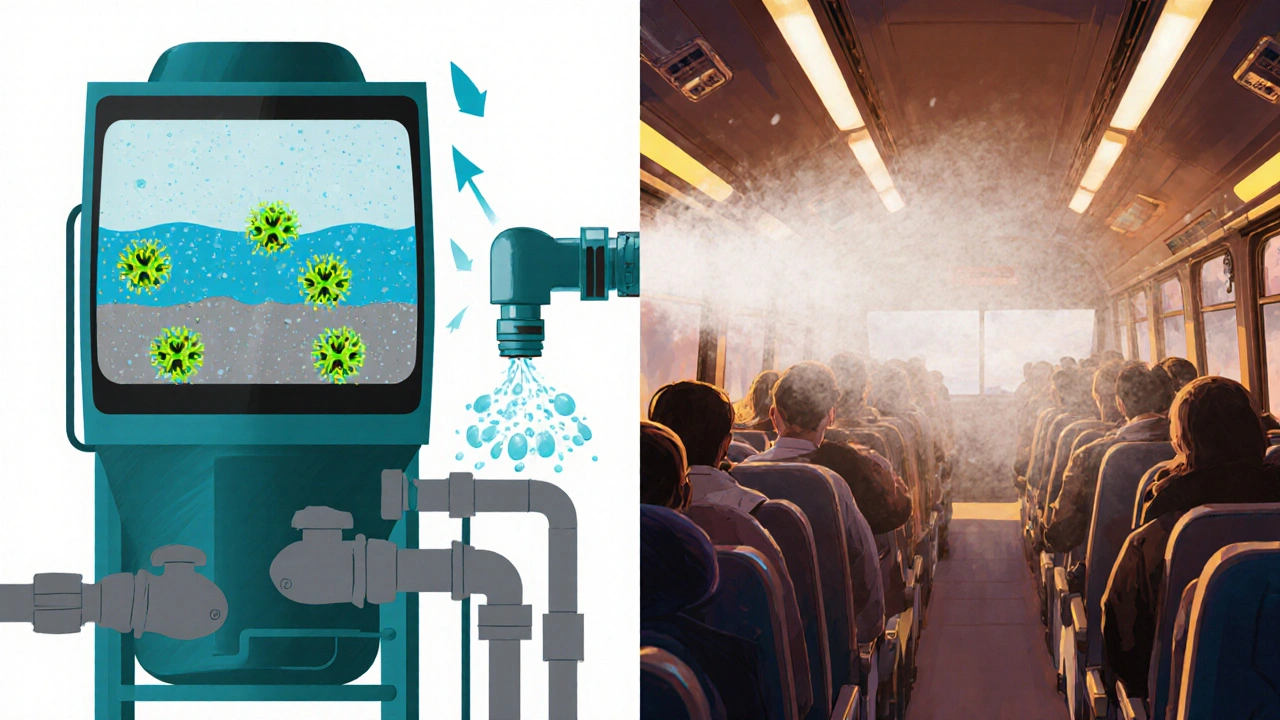
Real‑World Outbreaks
In 2019, a metropolitan bus company in Spain halted service after a cluster of 12 Legionnaire’s disease cases traced back to a faulty cooling‑tower spray system. The investigation revealed that the spray nozzles hadn’t been flushed for six months, allowing temperatures to sit in the sweet spot for bacterial growth.
Another notable case occurred in 2022 on a UK commuter train line. The railway’s new “eco‑cool” HVAC units used reclaimed water to reduce energy consumption. Unfortunately, the reclaimed water wasn’t treated adequately, and three passengers required hospitalization. The incident prompted the WHO to issue updated guidelines for water recycling in rail vehicles.
Spotting Symptoms Early
Legionella infections often masquerade as regular flu, but here are the hallmark signs to watch for within 2‑14 days after exposure:
- High fever (often >39°C/102°F)
- Chills and muscle aches
- Cough that may produce sputum
- Shortness of breath or chest pain
- Gastrointestinal upset (diarrhea, nausea)
If you develop any of these after a long ride, especially on a vehicle with known water‑system issues, seek medical attention promptly. A simple urine antigen test can confirm Legionella in minutes, allowing doctors to start antibiotics like levofloxacin or azithromycin quickly.
Prevention for Operators
Transport agencies wield the biggest influence over safety. Below is a checklist that many successful fleets follow:
- Implement a documented water‑management plan covering all cooling‑tower and HVAC components.
- Schedule weekly temperature checks; keep water below 20°C or above 50°C where feasible.
- Perform quarterly biocide dosing and document chlorine levels (target 0.5‑1ppm).
- Clean and descale heat exchangers every six months, using EPA‑approved disinfectants.
- Install point‑of‑use filters on high‑risk spray nozzles.
- Train maintenance crews on recognizing biofilm formation and proper flushing techniques.
- Maintain logs of all cleaning activities and make them auditable for health‑inspector reviews.
Many cities have adopted real‑time monitoring dashboards that alert managers when temperature or disinfectant levels drift out of range. The data not only prevents disease but also saves money by reducing emergency shutdowns.
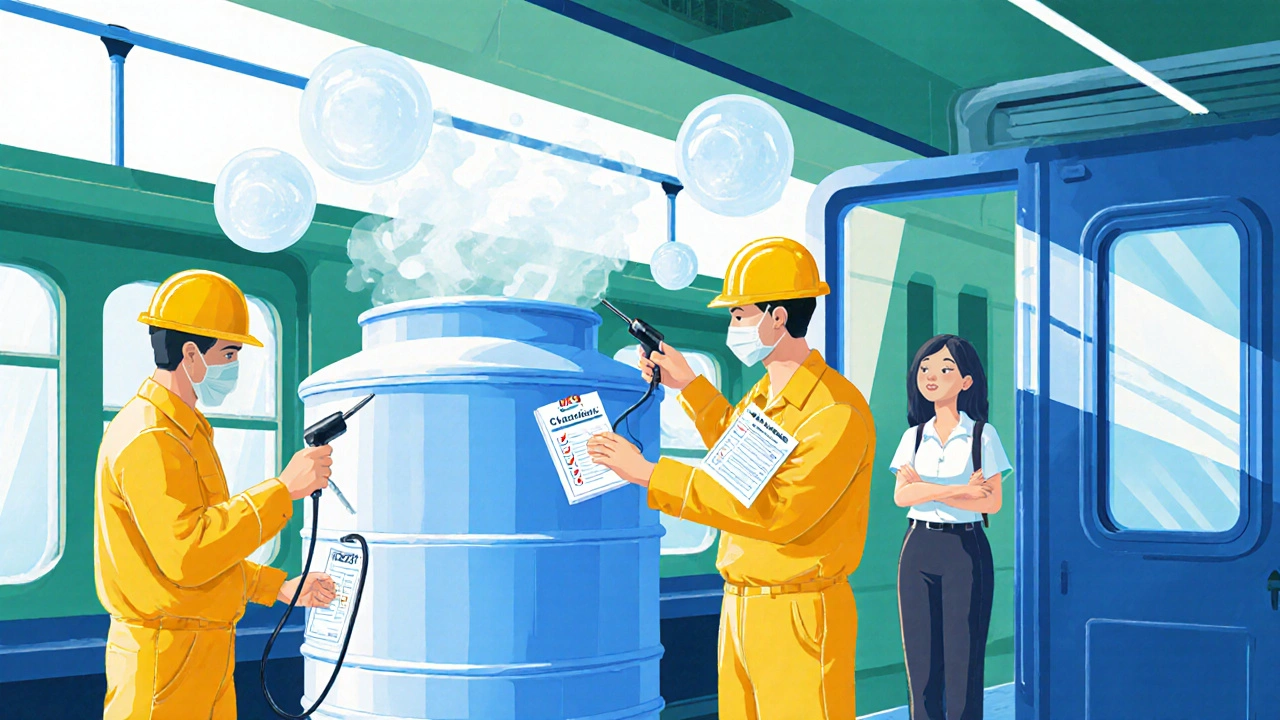
What Passengers Can Do
Even if you’re just a daily commuter, a few habits can lower exposure:
- Prefer seats near the doors where fresh air influx is strongest.
- Avoid standing directly under air‑conditioning vents if you notice a strong mist.
- If you feel a “wet” smell or see visible condensation on windows, report it to the driver or transit authority.
- Carry a small bottle of hand sanitizer and use it after touching high‑contact surfaces.
- Know the symptoms and don’t ignore a persistent fever after a long trip.
Being vocal helps operators fix problems faster. Many transport agencies now have mobile apps where riders can log concerns about water‑related odors or visible mist.
Quick Checklist for Fleet Managers
- Document water‑temperature logs weekly. \n
- Verify biocide concentrations after each dosing event.
- Conduct visual inspections of spray nozzles before peak season.
- Train staff on emergency decontamination procedures.
- Review incident reports quarterly and adjust maintenance schedules.
Frequently Asked Questions
Can Legionella survive on dry surfaces inside a bus?
Legionella needs water to live, so it doesn’t persist on dry seats or handrails. However, droplets that land on wet surfaces can dry and still contain viable bacteria for a short time, especially in humid cabins.
Is the disease contagious from person to person?
No. Legionnaire’s disease spreads only through inhaling contaminated aerosols, not through direct contact or coughing.
How long does it take for an outbreak to be detected?
Symptoms appear 2‑14 days after exposure, so health officials often spot clusters a week or more after the first case seeks care.
What antibiotics work best against Legionella?
Levofloxacin and azithromycin are first‑line treatments. Early administration dramatically improves recovery odds.
Are there any vaccines available?
No licensed vaccine exists for Legionella, but ongoing research aims to develop one for high‑risk occupational groups.
Legionnaire’s disease may sound rare, but when water systems on public transport are ignored, the risk can climb quickly. By keeping maintenance crews vigilant, encouraging riders to speak up, and staying alert to early symptoms, cities can keep their commuters safe and healthy.


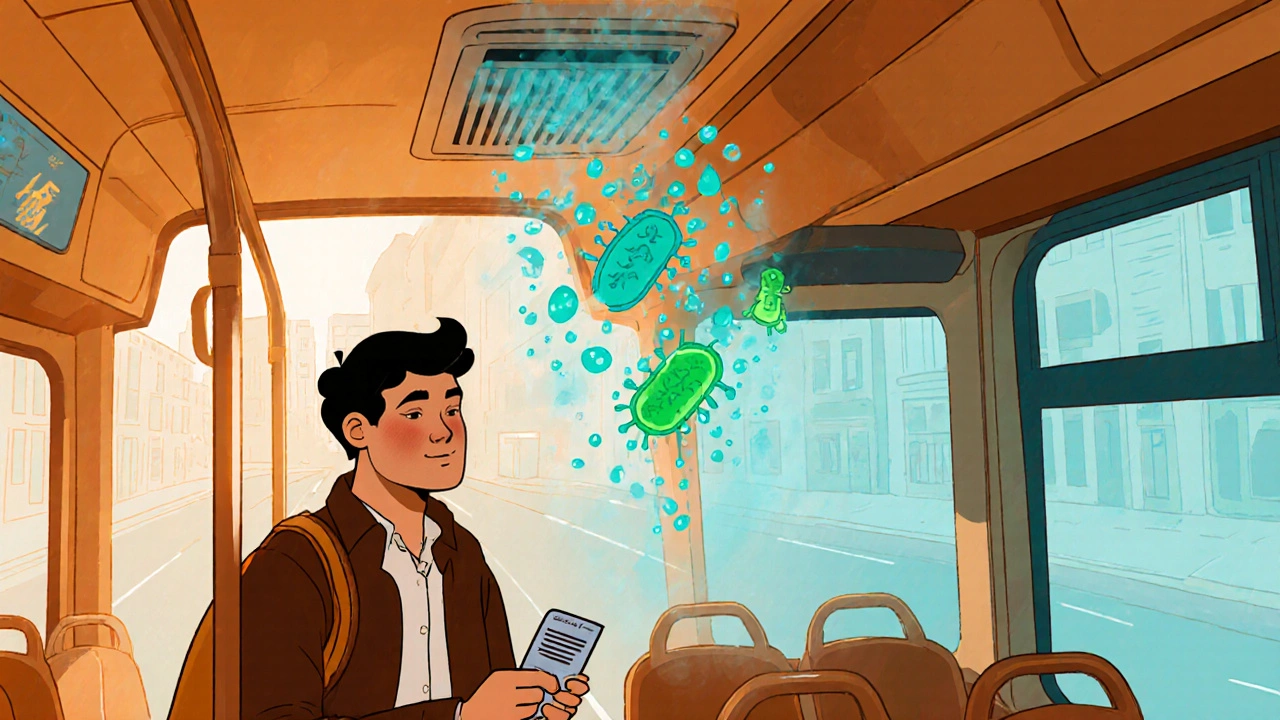
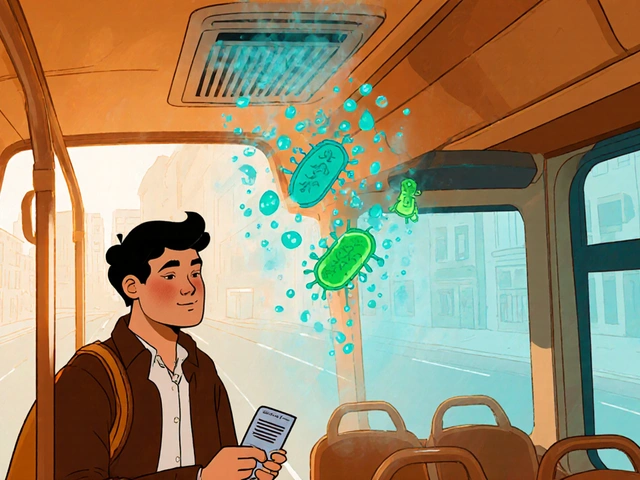

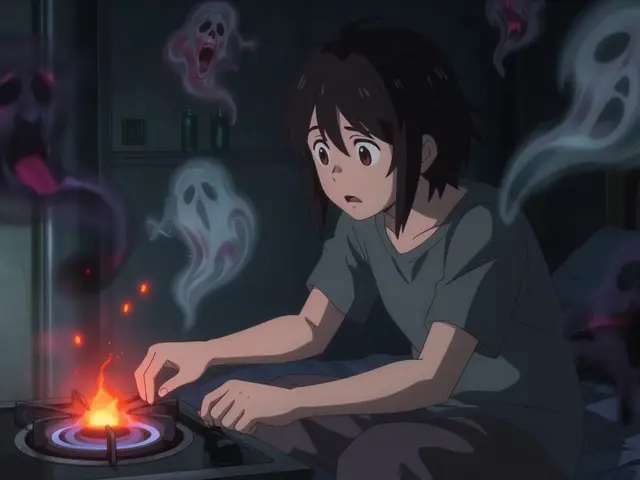



Comments (12)
Carissa Padilha
October 16, 2025 AT 20:21 PMThe truth about Legionella on buses is being hidden in plain sight. They tell us it’s a rare freak accident, but the data shows a steady climb in cases near major transit hubs. Every time a city upgrades its cooling towers, the contracts go to the same shadowy firms that also supply the water treatment chemicals. Those companies have a vested interest in keeping the public clueless while they profit from endless maintenance cycles. The CDC reports are filtered through layers of bureaucracy that conveniently omit the correlation between budget cuts and outbreak spikes. If you listen to the whistleblowers who have tried to raise alarms, they are silenced or dismissed as “paranoid”. The aerosols that spread the bacteria are essentially invisible weapons that can be triggered by a simple increase in cabin temperature. Imagine a commuter standing under a vent on a hot summer day, inhaling a cloud of micro‑droplets that have been breeding for weeks. That scenario is not a fiction; it happened in Spain last year and the official report was buried in a 200‑page PDF nobody reads. Moreover, the “eco‑cool” systems praised as green innovations are often just a re‑branding of old, un‑treated water loops. The chemistry of chlorine decay in stagnant tanks is well documented, yet the guidelines are written by the same lobbyists who sell the chemicals. In some cities, the water temperature logs are falsified to meet the arbitrary “safe” thresholds, while the real temperature sits squarely in the Legionella sweet spot. This manipulation is not a mistake, it is a calculated risk that authorities are willing to gamble with because they fear the cost of a genuine overhaul. The public’s trust is eroded when a handful of patients suddenly die from pneumonia that could have been prevented. Only a transparent, community‑driven monitoring system could expose the shortcuts and force accountability. Until then, every ride on a bus or train is a gamble with your lungs, and the odds are stacked against you.
Sara Werb
October 27, 2025 AT 05:21 AMWow!!! The news about Legionella on our trains is a total nightmare, and it's all because of those lazy bureaucrats who can't even keep a simple cooling tower clean!!! The whole system is a mess, teher's water everywhere, the vents are spraying like a freakin' sprinkler party, and people are just sitting there breathing in toxic mist!!! If we don't raise our voices, the next outbreak will hit right in the heart of our great nation, and we will be the ones to blame!!! This is not just a health issue, it's an attack on our freedom and our pride!!!
Winston Bar
November 6, 2025 AT 15:21 PMHonestly, this article sounds like another alarmist piece trying to scare commuters for clicks; sure, Legionella exists, but the risk on a daily bus ride is pretty low compared to, say, drinking contaminated water at a backyard BBQ. I mean, the maintenance crews do their job, and most of the time you’re fine. Still, I get why people freak out-who doesn't love a good drama about hidden germs. Anyway, let’s not panic, but keep an eye on any weird smells, okay.
Russell Abelido
November 13, 2025 AT 14:01 PMReading your take really puts the whole issue into perspective, and I can’t help but feel a mix of worry and admiration for those who try to shine a light on these hidden dangers :) It reminds me that public health isn’t just about statistics, it’s about the lived experiences of everyday riders, and the silent battles they face. Even if the system seems opaque, our collective awareness can push for real change, and that hopeful thought keeps me going.
Steve Holmes
November 21, 2025 AT 16:28 PMGreat post, very thorough, and it really breaks down the science in a way that anyone can understand, especially the part about temperature ranges, which is often overlooked, and the practical steps for fleet managers, which are essential for preventing outbreaks, and the simple tips for commuters, which empower the public, all of which makes this guide incredibly valuable.
genevieve gaudet
November 27, 2025 AT 11:21 AMi totally get the frustration, but let's also think about how cultures view water safety, and how different city policies can either amplify or reduce these hidden risks. In many places, the community actually participates in monitoring, which brings a sense of shared responsibility, and that's something worth celebrating despite the chaotic headlines.
Samantha Oldrid
December 2, 2025 AT 02:28 AMSure, because government water filters are totally infallible.
Kate Marr
December 5, 2025 AT 13:48 PMWe need to stop letting these foreign tech companies dictate our transit standards-our own engineers know best, and we should demand proudly American solutions! 🇺🇸🚍
Emily (Emma) Majerus
December 7, 2025 AT 21:21 PMHey, keep your head up! Even if the bus feels like a sauna sometimes, staying informed and reporting any weird smells can make a huge difference for everyone.
Virginia Dominguez Gonzales
December 10, 2025 AT 04:54 AMImagine the relief you’ll feel when you see a clean, well‑maintained HVAC system humming quietly, knowing that no invisible foe is lurking in the air-it's like a breath of fresh confidence that lifts the whole commute into something uplifting and safe!
Richard O'Callaghan
December 13, 2025 AT 16:14 PMso i was on the train last week, i sat next to this guy who kept coughing, and i thought maybe i should ask him if he felt okay, but then i remembered the article and thought maybe i should just keep my distance, its kinda weird how personal health stuff becomes a public convo.
Nickolas Mark Ewald
December 19, 2025 AT 11:08 AMGood info, thanks for sharing. Easy steps for drivers and riders can really lower the risk.